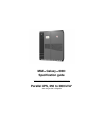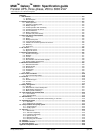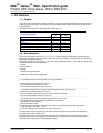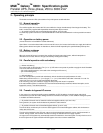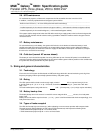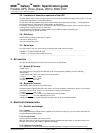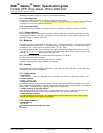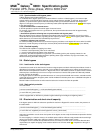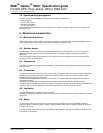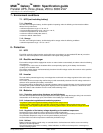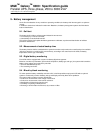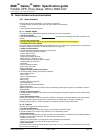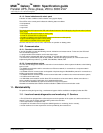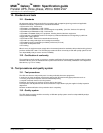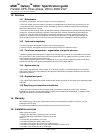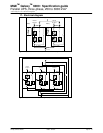
MGE
TM
Galaxy
TM
6000 : Specification guide
Parallel UPS, three-phase, 250 to 3000 kVA*
* Power rating for an N+1 redundant configuration
APC By Schneider Electric Edition - 03/2009 Spec. E - 8
5.3.3 - Synchronisation with bypass power
ω When bypass power is within tolerances
To enable transfer to bypass power (see conditions below in section 5.4 "Static-bypass"), the inverter output
voltage shall be synchronised with the bypass source voltage whenever possible. To that end, during normal
operation, a synchronisation system shall automatically limit the phase deviation between the voltages to 3
degrees, if the bypass source frequency is sufficiently stable (within adjustable tolerances of ± 0.5 Hz with respect
to the rated frequency).
ω Synchronisation with an external source
It shall be possible to synchronise with all types of external source.
For example, if the bypass source is a generator set, the synchronization tolerances shall be approximately
± 2 Hz (adjustable).
ω Autonomous operation following loss of synchronisation with bypass power
When the bypass source frequency deviates beyond these limits, the inverter shall switch over to free-running
mode with internal synchronisation, regulating its own frequency to within ± 0.1 %. When bypass power returns to
within tolerances, the inverter shall automatically resynchronise.
ω Variation in frequency per unit time
To avoid transmitting to the inverter any excessive frequency variations on the bypass AC source when it is within
tolerances, inverter frequency variations per unit time (dF/dt) shall be limited to 1 Hz/s or 2 Hz/s (user defined).
5.3.4 - Overload capacity
The UPS shall be capable of supplying for at least:
ω 1 minutes a load representing 165% of the rated load;
ω 1 second a load representing 200% of the rated load.
If necessary, the UPS shall operate as a generator (current limiting) with a peak capacity of 233% for 150
milliseconds, to allow highly disturbed transient operating states (high overloads, very high crest factors, etc.)
without transferring the load to the bypass.
5.4 - Static bypass
5.4.1 - Load transfer to the static bypass
Instantaneous transfer of the load from the inverters to bypass power and back shall take place without a break or
disturbance in the supply of power to the load, on the condition that the bypass source voltage and frequency are
within the tolerances specified in section 4.1 "Bypass AC source" and that the inverters are synchronized. Transfer
shall take place automatically in the event of a major overload or an internal UPS-system fault. Manually initiated
transfer shall also be possible.
If the bypass power is outside the specified tolerances or is not synchronized with the inverters, automatic transfer
of the load from the inverters to bypass power shall be inhibited or shall take place after a calibrated interruption of
500 to 800 milliseconds.
Manual initiation of this transfer as well as transfer back to the inverters shall also be possible.
5.4.2 - Static-switch protection
The static switch
.........................................................................................................................................................................
[ common centralized-bypass ] (
)
with centralized-bypass cabinet)
.........................................................................................................................................................................
[ in each UPS unit ] (other cases)
.........................................................................................................................................................................
shall be equipped with an RC filter for protection against switching overvoltages and lightning strikes.
5.5 - Discrimination and short-circuit capacity
If the bypass power is within the tolerances specified in section 4.2 "Bypass AC source" section, the presence of
the static switch
.........................................................................................................................................................................
[ common centralized-bypass ] (
)
with centralized-bypass cabinet)
.........................................................................................................................................................................
[ in each UPS unit, supplied by the same bypass AC source ] (other cases)
.........................................................................................................................................................................
shall make it possible to use the short-circuit power of the bypass source to trip the downstream protection devices
of the inverter.
To ensure tripping in a selective manner, the available power shall be sufficient to trip protection devices with high
ratings (circuit breaker rated In/2 or UR fuses rated In/4, where In is the rated inverter current).
If the bypass source is outside the specified tolerances, the inverter on its own shall, for the same discrimination
requirements, be capable of tripping circuit breakers rated In/2 or UR fuses rated In/4, irrespective of the type of
short-circuit.



